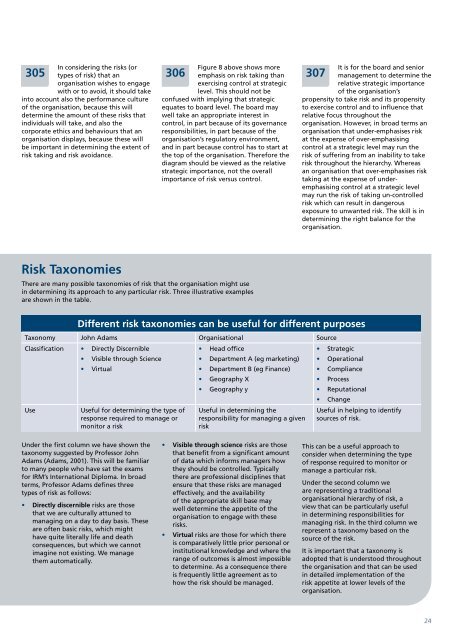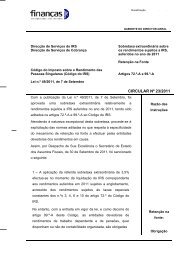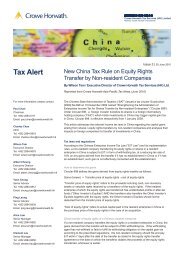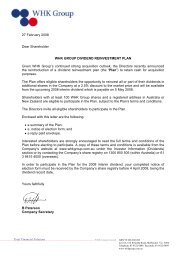Guidance Paper - The Institute of Risk Management
Guidance Paper - The Institute of Risk Management
Guidance Paper - The Institute of Risk Management
You also want an ePaper? Increase the reach of your titles
YUMPU automatically turns print PDFs into web optimized ePapers that Google loves.
In considering the risks (or<br />
305 types <strong>of</strong> risk) that an<br />
organisation wishes to engage<br />
with or to avoid, it should take<br />
into account also the performance culture<br />
<strong>of</strong> the organisation, because this will<br />
determine the amount <strong>of</strong> these risks that<br />
individuals will take, and also the<br />
corporate ethics and behaviours that an<br />
organisation displays, because these will<br />
be important in determining the extent <strong>of</strong><br />
risk taking and risk avoidance.<br />
Figure 8 above shows more<br />
306 emphasis on risk taking than<br />
exercising control at strategic<br />
level. This should not be<br />
confused with implying that strategic<br />
equates to board level. <strong>The</strong> board may<br />
well take an appropriate interest in<br />
control, in part because <strong>of</strong> its governance<br />
responsibilities, in part because <strong>of</strong> the<br />
organisation’s regulatory environment,<br />
and in part because control has to start at<br />
the top <strong>of</strong> the organisation. <strong>The</strong>refore the<br />
diagram should be viewed as the relative<br />
strategic importance, not the overall<br />
importance <strong>of</strong> risk versus control.<br />
It is for the board and senior<br />
307 management to determine the<br />
relative strategic importance<br />
<strong>of</strong> the organisation’s<br />
propensity to take risk and its propensity<br />
to exercise control and to influence that<br />
relative focus throughout the<br />
organisation. However, in broad terms an<br />
organisation that under-emphasises risk<br />
at the expense <strong>of</strong> over-emphasising<br />
control at a strategic level may run the<br />
risk <strong>of</strong> suffering from an inability to take<br />
risk throughout the hierarchy. Whereas<br />
an organisation that over-emphasises risk<br />
taking at the expense <strong>of</strong> underemphasising<br />
control at a strategic level<br />
may run the risk <strong>of</strong> taking un-controlled<br />
risk which can result in dangerous<br />
exposure to unwanted risk. <strong>The</strong> skill is in<br />
determining the right balance for the<br />
organisation.<br />
<strong>Risk</strong> Taxonomies<br />
<strong>The</strong>re are many possible taxonomies <strong>of</strong> risk that the organisation might use<br />
in determining its approach to any particular risk. Three illustrative examples<br />
are shown in the table.<br />
Different risk taxonomies can be useful for different purposes<br />
Taxonomy John Adams Organisational Source<br />
Classification • Directly Discernible<br />
• Head <strong>of</strong>fice<br />
• Strategic<br />
• Visible through Science<br />
• Department A (eg marketing) • Operational<br />
• Virtual<br />
• Department B (eg Finance) • Compliance<br />
• Geography X<br />
• Process<br />
• Geography y<br />
• ReputationaI<br />
• Change<br />
Use<br />
Useful for determining the type <strong>of</strong><br />
response required to manage or<br />
monitor a risk<br />
Useful in determining the<br />
responsibility for managing a given<br />
risk<br />
Useful in helping to identify<br />
sources <strong>of</strong> risk.<br />
Under the first column we have shown the<br />
taxonomy suggested by Pr<strong>of</strong>essor John<br />
Adams (Adams, 2001). This will be familiar<br />
to many people who have sat the exams<br />
for IRM’s International Diploma. In broad<br />
terms, Pr<strong>of</strong>essor Adams defines three<br />
types <strong>of</strong> risk as follows:<br />
• Directly discernible risks are those<br />
that we are culturally attuned to<br />
managing on a day to day basis. <strong>The</strong>se<br />
are <strong>of</strong>ten basic risks, which might<br />
have quite literally life and death<br />
consequences, but which we cannot<br />
imagine not existing. We manage<br />
them automatically.<br />
• Visible through science risks are those<br />
that benefit from a significant amount<br />
<strong>of</strong> data which informs managers how<br />
they should be controlled. Typically<br />
there are pr<strong>of</strong>essional disciplines that<br />
ensure that these risks are managed<br />
effectively, and the availability<br />
<strong>of</strong> the appropriate skill base may<br />
well determine the appetite <strong>of</strong> the<br />
organisation to engage with these<br />
risks.<br />
• Virtual risks are those for which there<br />
is comparatively little prior personal or<br />
institutional knowledge and where the<br />
range <strong>of</strong> outcomes is almost impossible<br />
to determine. As a consequence there<br />
is frequently little agreement as to<br />
how the risk should be managed.<br />
This can be a useful approach to<br />
consider when determining the type<br />
<strong>of</strong> response required to monitor or<br />
manage a particular risk.<br />
Under the second column we<br />
are representing a traditional<br />
organisational hierarchy <strong>of</strong> risk, a<br />
view that can be particularly useful<br />
in determining responsibilities for<br />
managing risk. In the third column we<br />
represent a taxonomy based on the<br />
source <strong>of</strong> the risk.<br />
It is important that a taxonomy is<br />
adopted that is understood throughout<br />
the organisation and that can be used<br />
in detailed implementation <strong>of</strong> the<br />
risk appetite at lower levels <strong>of</strong> the<br />
organisation.<br />
24

















